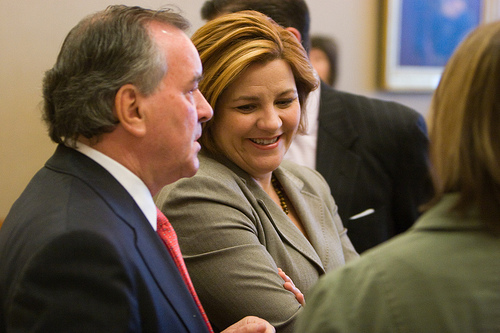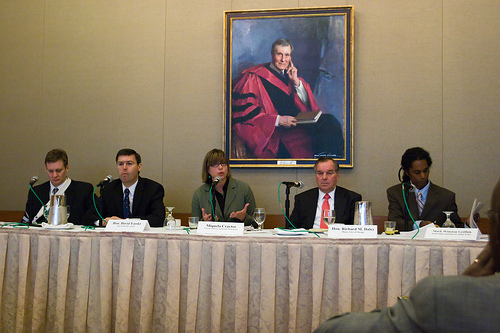Karin Dryhurst
Liveblogging the Marketplace of Ideas: From Concrete Jungle to Urban Oasis

Welcome to the live blog of the Drum Major Institute's Marketplace of Ideas! Today we welcome Chicago Mayor Richard M. Daley to discuss Chicago's efforts to turn a concrete jungle into an urban oasis.
Chicago has made itself the national leader in the construction of green roofs. Led by Mayor Daley, Chicago uses green building requirements, grants, expedited permits, and other financial assistance to promote green roof construction throughout the city. These roofs can reduce roof temperatures by as much as 29 degrees during the summertime.
Chicago's Green Roof Grant Program has assisted more than 20 green roof projects a year since 2005, including City Hall.
New York City Council Speaker Christine C. Quinn will introduce Mayor Daley to the panel, which includes the Honorable David Yassky, New York City Council Member; Miquela Craytor, Executive Director of Sustainable South Bronx; and Carter Strickland, Sustainability Advisor to the Mayor's Office. DMI's Executive Director Mark Winston Griffith will moderate.
8:21 a.m. Mark Winston Griffith introduces Council Speaker Quinn. She thanks DMI for bringing the panel together. Ms. Quinn points out that for far too long, urban America has been seen as in opposition to environmentalism. She says city dwellers need to show rural and suburban Americans that they can live in an urban environment and do it in a green way.
Ms. Quinn admits that Mr. Daley is making New York look bad. While Chicago's City Hall is a garden, New York's must be buttressed with scaffolding. She says New York needs to focus on the buildings that exist and green them in a way that creates good jobs. Legislation to be introduced next month will audit buildings and require many to green their buildings. She says the program could create 19,000 jobs.
8:27 a.m. Ms. Quinn introduces Mr. Daley.
Mr. Daley acknowledges the competition between cities, a competition which fosters innovation at the local level. He says forms like the Marketplace of Ideas allow cities to share new ideas and develop creative solutions.
Mr. Daley points out that the environment is key to the future of cities.
"Nature can coexist in an urban environment," he said. "For far too long we looked the other way."
Mr. Daley says Chicago leads by example. By greening public buildings, such as schools and fire stations, the private sector and city residents will follow.
The future lies in cities, he says. Mr. Daley says programs like the Green Roofs program address two desires of modern men and women: urban living and open space.
Chicago now has more than 600 green roofs, totaling more than 7 million square feet. His interest in green roofs was sparked by a trip to Hamburg, Germany, where they had already incorporated green roofs. Chicago built its first green roof in 2000.
Mr. Daley says environmentalism makes economic sense. He points to programs in Chicago that coordinate environmental projects and ex-offender programs to create sustainable jobs.
8:44 a.m. Mark Winston Griffith introduces Mr. Strickland and asks why the City has focused on painting roofs white rather than constructing green roofs.
Mr. Strickland says the simple answer is cost. He says the City has to reverse four centuries of urbanization. New York's sidewalks and streets account for 25 percent of its space compared to the 12 percent covered by roofs making it more cost-effective to green the sidewalks and medians.
Mark asks whether the City is sacrificing any benefits by choosing white roofs over green roofs.
Mr. Strickland says the City promotes different sustainable efforts through tax incentives for solar paneling and green roofs.
8:49 a.m. Mark introduces Miquela Craytor of Sustainable South Bronx as a prime mover in the creation of the South Bronx greenway. He asks what she thinks about the City's focus on white roofs. 
Ms. Craytor responds that while white roofs are more affordable, they lack the public health and job benefits of green roofs.
Mark asks Ms. Craytor how much we should be willing to pay for such programs.
She says changing the building process can limits costs to the City while providing benefits to taxpayers by reducing the effects of climate change and pollution on quality of life. She suggests advocates continue to pressure New York City leadership to develop green initiatives.
8:56 a.m. Mark introduces Council Member David Yassky. Mark asks Mr. Yassky about the political obstacles to green roofs and other environmental initiatives.
Mr. Yassky says the City must provide incentives and allow the private sector to determine the best solution for them, whether that means solar paneling, green roofs or white roofs. He highlights the fact that old policy continues to push developers toward unsustainable building, and that the City must work to change that.
Mr. Yassky notes that inertia is common in government and in the public mindset. It will take outreach to make people understand the benefits of green initiatives.
9:05 a.m. Mr. Strickland joins in to point to legislation passed last year that promotes the use of Energy Star appliances and white roofs.
9:06 a.m. Mark asks Mr. Daley how progressives can aggressively promote these programs.
Mr. Daley says different strategies must be used in concert in order to be effective. He says Chicago leads by example by building green roofs on schools and providing children with access to them.
He sits down with developers and other interest holders to explain what they're doing and why it matters.
9:10 a.m. Mark opens questions to the audience.
Colvin W. Grannum, President of the Bedford Stuyvesant Restoration Corporation, asks the panel to explain how the City can promote environmental initiatives in working class communities, with an eye to public housing and the stimulus.
9:13 a.m. Mr. Yassky points out that public housing can provide government the opportunity to show leadership but that public buildings actually trail the business community in green roof construction. He said he had hoped stimulus funding directed to public housing would be used for an initiative to put wind power turbines on buildings.
9:17 a.m. Ms. Craytor points to outreach by Sustainable South Bronx to educate low-income communities. She says the organization has educated ex-offenders through its job training programs. She says its important to make environmentalism digestible for homeowners so that people will participate in these programs.
Mr. Daley says its environmental programs put people to work in communities with little access to jobs.
9:20 a.m. Leslie Hoffman, Executive Hoffman of Earth Pledge, asks the panel to explain how the City can promote a local green industry, creating jobs and lowering the costs of green projects.
Mr. Daley says Chicago waives permit costs and hires the homeless for its green initiatives.
Mr. Yassky points to a warehouse in Brooklyn that hired local workers to install solar panels. Those workers now have the experience to compete for large projects.
Ms. Craytor laments that the PlaNYC program to plant a million trees doesn't address the lack of local growers.
Ms. Strickland said the market will go in that direction.
9:29 a.m. An audience member asks the panel how programs like congestion pricing can be worked into a global environmental strategy.
Mr. Daley says travel to places like New York allows him to cherry-pick programs that may work for Chicago.
"Mayors across the world are the leading advocates for dealing with the environment," he says. "We have to deal with these issues at a local level."
Mr. Yassky says ideas are propagating. He points out that when a city like New York or Chicago attempts something new, the effects go beyond the city borders. He cites the legislation that would green New York taxis and says council members from Los Angeles and Miami called the next day.
9:35 a.m. An audience member questions the poor performance of New York on LEEDs buildings compared to cities like Boston and Pittsburgh.
Mr. Strickland points out that the vast majority of buildings that will exist in New York in 2030 have already been built, making it necessary to focus on existing buildings.
Ms. Craytor says leaders need to think of cities as systems and think about all the different players from the public and private sectors.
9:43 a.m. Robin Simmen of Brooklyn Botanic Garden thanks Mr. Daley for promoting green roofs and asks him how Chicago spread the message.
Mr. Daley highlights a program that dedicates planted trees to school classes whose students then take care of the trees. Chicago also coordinates with non-profit organizations to explain to homeowners why their sidewalks have been dug up to plant trees.
Ms. Craytor notes that after hiring two graduate students as stewards for trees in the South Bronx, their presence has cultivated more stewards in the area ready to prune.
9:49 a.m. Mark asks the panel whether the stigma of cities as concrete jungles has changed.
Ms. Craytor says more people seem to be aware of the green movement. She points to office workers asking her about greening their office through recycling programs and to South Bronx residents talking about greening their homes even as they struggle to meet basic needs.
Mr. Yassky says the City is undergoing a transformation as leaders uncover layers of unsustainable policy and change it.
9:52 Mark asks how cities can work toward sustainability even as the country faces these tough economic times.
Mr. Strickland says the push is harder but that cities will still develop smart policies.
"Cities are laboratories of democracy," he says.
He says cities don't have a choice but to innovate as their populations continue to grow. More people live in cities worldwide than other areas.
Mr. Daley says rather than the federal government, mayors of urban areas will lead the way.
Karin Dryhurst: Author Bio | Other Posts
Posted at 8:19 AM, May 18, 2009 in
Cities | Community Development | Economic Opportunity | Economic Stimulus | Economy | Energy & Environment | Environmental Justice | Housing | Infrastructure | New York | Politics | Urban Affairs
Permalink | Email to Friend










